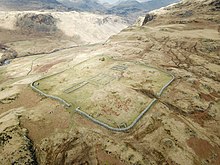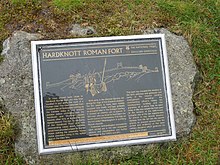Hardknott Roman Fort
 Hardknott Roman Fort and parade ground | |
| Location | Cumbria, England |
|---|---|
| Region | Britannia |
| Coordinates | 54°24′10″N 3°12′19″W / 54.40278°N 3.20528°W |
| Type | Castrum |
Hardknott Roman Fort is an archeological site, the remains of the Roman fort Mediobogdum,[1] located on the western side of the Hardknott Pass in the English county of Cumbria (formerly part of Cumberland).
Location and name
The fort was built on a rocky spur giving a superb view over the River Esk in both upper and lower Eskdale, and protecting Hardknott Pass. At an altitude of 800 feet, it isn't the highest fort in the Roman province of Britannia, the highest fort is Epiacum or Whitley Castle, also in Cumbria, at an altitude of 1,050 feet.
The ruins have been commonly known in recent times as Hardknott Fort or Hardknott Castle, but are identified from the Ravenna Cosmography as the Mediobogdum fort,[2] situated along the road between the forts of Galava (Ambleside) and Glannoventa (Ravenglass).
Classical history
Built between about 120 and 138, the fort was abandoned during the Antonine advance into Scotland during the mid-2nd century. The fort was reoccupied around 200 and continued in use until the last years of the 4th century. During this time, an extensive vicus developed outside the fort.[3] The Roman garrison here was a detachment of 500 cavalry of the 4th Cohort of Dalmatians from the Dalmatian coast.[4]
Description

The fort is square with rounded corners, 114 metres long externally, or 105 metres internally, the rampart wall being about 1.7 metres thick with ditches adding to the total width of the rampart. The low walls of the fort were "restored" some years ago, a slate course showing the height of the walls before their rebuilding.
The outer wall has four gates, at the centre of each side, and lookout towers at each corner. Within the walls are the remaining outlines of several buildings: two side-by-side granaries, the garrison headquarters building and garrison commander's villa, or Praetorium. In addition to these stone buildings, timber structures would have housed barracks for the mounted auxilia.[4]

Outside the square of the fort is the remains of the bath house (which has a rare circular sudatorium), and the levelled parade ground, which is considered to be the finest surviving example in the Western Empire.[citation needed]

The parade ground is approximately two hundred yards higher up the slope to the east of the fort. A track led up to it from the East Gate of the fort. A plan of the fort by R. G. Collingwood in 1930 shows the parade ground to have been as big as the fort, with embanked edges to ensure a level surface.
Modern site
The fort is on land owned by the National Trust, part of the Trust's Wasdale, Eskdale and Duddon property, and maintained by English Heritage.
Archeological activity
Leather objects from Roman occupation have been found at the site. A 1965 excavation found a piece of leather near the granary, thought to be part of soldier's jerkin. Another excavation in 1968 by Dorothy Charlesworth and J. H. Thornton uncovered more leather, including several shoes.[5]
Cultural influence
Hardknott is the eponymous fort in the Jack Whyte novel, The Fort at River's Bend.
References
- ^ Esmonde Cleary, A., DARMC, R. Talbert, S. Vanderbilt, R. Warner, S. Gillies, T. Elliott. "Places: 89243 ('Medibogdo')". Pleiades. Retrieved May 25, 2013.
{{cite web}}: CS1 maint: multiple names: authors list (link) - ^ Rivet, A. L. F.; Smith, Colin (1979). The Place-Names of Roman Britain. London: B. T. Batsford. ISBN 0-7134-2077-4.
- ^ Jones, J. S. (2000). Hardknott Roman Fort. Kendal: Archaeological Society of Cumbria.
- ^ a b "Hardknott Roman Fort – the Borders of Empire". Cambridgemilitaryhistory.com. 31 March 2015. Retrieved 31 August 2017.
- ^ Charlesworth, Dorothy; Thornton, J. H. (1973). "Leather Found in Mediobogdum, the Roman Fort of Hardknott". Britannia. 4: 141–152. doi:10.2307/525862. JSTOR 525862.
External links
- Eskdale and Duddon information at the National Trust
- Hardknott Roman Fort information at English Heritage
- Hardknott Roman Fort Link to website cambridgemilitaryhistory.com which discusses Hardknott Roman Fort
- Roman sites in Cumbria
- English Heritage sites in Cumbria
- History of Cumberland
- History of Cumbria
- Military history of Cumbria
- National Trust properties in Cumbria
- Roman fortifications in England
- Tourist attractions in Cumbria
- Archaeological sites in Cumbria
- Former populated places in Cumbria
- Ruins in Cumbria
- Roman legionary fortresses in England

